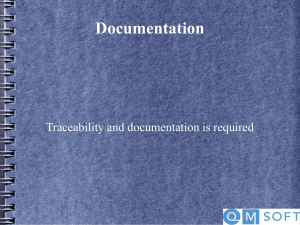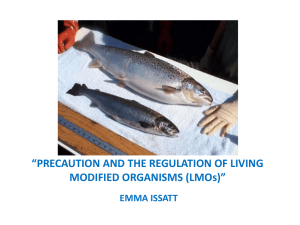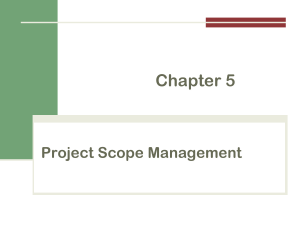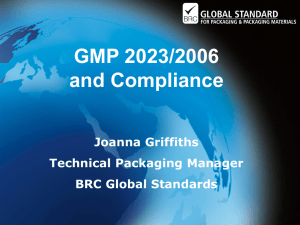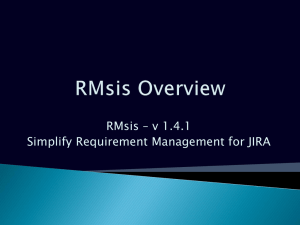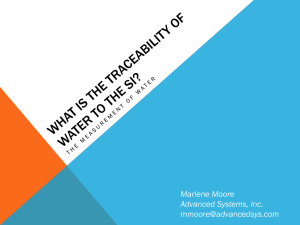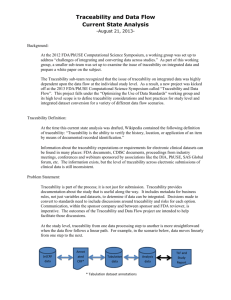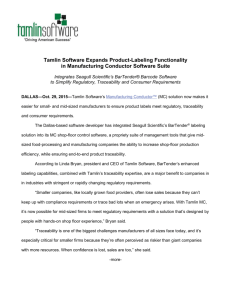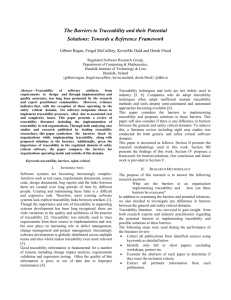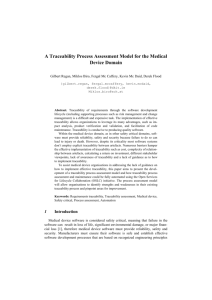HOOD Requirements Definition Process
advertisement
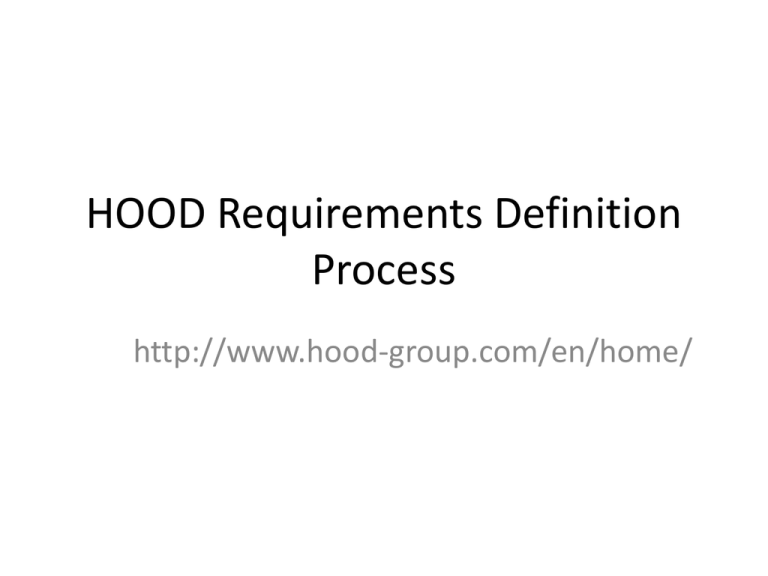
HOOD Requirements Definition Process http://www.hood-group.com/en/home/ HOOD Process from ‘Requirements Management’ Springer 2007, Colin Hood et al Initiate Scope Identify Interfaces Define Interfaces Define Stakeholders and Roles Modelling Definition Elicitation Specification Derive Requirements Analyse Review Scope • We need to decide what is inside the system and what is outside the system • What activities are part of this process? – Identify Interfaces – Define Interfaces – Define Stakeholders and Roles Identifying Interfaces • You need to interview your customer (and later your stakeholders) to establish what the boundaries are. • For example…an online system has to be developed to help students in their final year pick a project title. • On initial discussions with the customer (Coordinator for final year projects) it appears that there are several aspects to the problem. Final Year Projects Problem Propose Projects Final Year Projects Select Projects Allocate Supervisor Proposing a Project External Submit Proposal Staff <<extends>> Negotiate Proposal Student Coordinator Allocate Supervisor Identify Supervisors Staff Student Match Supervisors to students HOS Scope Identify Supervisors Staff External Match Supervisors to students Student Submit Proposal Staff <<extends>> Negotiate Proposal Student Coordinator HOS Defining the Interfaces • We have identified interfaces between the system of interest to us and the ‘others’ of no interest to us. • Defining the interface would involve describing the dialogue that goes on between us and them • We can see already that we need to interface with the HOS • A description of this might be provided in a number of ways – Plain narrative – Boundary (interface) class in a class diagram – Use Case Text Use Case: Match Supervisors to Students Trigger: Complete set of proposals are available. 1. Execute matching algorithm 2. Inform Student of supervisor 3. Inform Supervisor of Students 4. Inform HOS of allocation Termination: All students are allocated a supervisor-project Class Diagram Allocate Allocation List:(Student,Supervisor, Proposal) Perform Matching algorithm <<interface>> Inform Contact Details Inform Student Inform Supervisor Inform HOS Define Stakeholders and Roles Task Role Stakeholder Negotiate a proposal Proposer Approver Student Coordinator External Company HOS Communicate Allocation Coordination Staff Student HOS Coordinator Calculate Allocation Calculator Coordinator Course Director Definition of Requirements Elicitation • Collect requirements from stakeholders via fact finding techniques such as interview, observation, participation etc. • Collect requirements from existing specifications or other documentation • Use UML models to clarify your understanding with the stakeholders Using UML Models The stakeholders have suggested… •A supervisor must know of the allocation before the student. •A student must contact the supervisor within 48 hours •A supervisor must be a member of academic staff Staff Student Supervisor System One Hour Max 48 Hours Max Supervisor Using UML Models A stakeholder has described… The allocation must match students to proposals on the basis of performance Obtain next student Read Next Choice Another student Choice taken Another choice Allocate to Supervisor To do list Communicating Requirements • The use of the diagrams helps us to clarify our understanding of the requirements elicited from the stakeholders. • Of course in some cases the diagrams may not be understood by stakeholders when the picture becomes complicated • In this way, a stakeholder may agree that a diagram accurately represents an understanding of a requirement only for the engineer to find out later that it does not • There is no easy solution to this problem! Specification • We specify requirements in order to convey requirements to others. • Stakeholders are important receivers of requirements statements but so are designers and engineers who will turn the requirements into working solutions. • A Requirements specification includes a list of uniquely identifiable and atomic requirements • The UML diagrams are important clarifiers of these specified requirements • Requirements specification should include these UML diagrams where necessary for clarification • Volere Requirements Templates provide a useful basis for specifying requirements Analysis • Study, examine, investigate and scrutinise every requirement. • Reach an understanding of the requirements with all parties. • Consider if the requirements, as specified, are likely to lead to a system which will satisfy the users in their own environment (Validation) Reviews • Check that the specified requirements conform to the quality criteria (PPQA) – – – – – – – – – – Atomic Identifiable Understandable Unambiguous Testable Realisable Non-redundant Consistent Traceable Complete Doing it Capable Expert HOOD Capability Levels Mapping the HOOD Process to CMMI HOOD Scope is defined through: •Identifying interfaces •Defining interfaces •Defining stakeholders and roles Requirements are defined by •Elicitation •Specification •Analysis •Review RD SG1 Develop customer requirements SP1.1 Elicit needs SP1.2 Develop the customer requirements SG2 Develop product requirements SP2.1 Establish product and product component requirements SP2.2Allocate product component requirements SP2.3Identify interface requirements SG3 Analyse and validate requirements SP3.1 Establish operational concepts and scenarios SP3.2 Establish a definition of required functionality SP3.3 Analyse requirements SP3.4 Analyse requirements to achieve balance SP3.5 Validate requirements PPQA Requirements Management • REQM is the sum of all activities which take place after requirements have been specified (during RD) that are necessary to keep the value of requirements at a high level • In other words, without carrying certain activities, the requirements specification becomes less and less valuable/meaningful over time • So what might these activities be… – – – – – Obtain understanding of requirements Obtain commitment to requirements Manage requirements changes Maintain bi-directional traceability of requirements Identify inconsistencies between project work and requirements Lets consider some simple requirements 1. The machine must produce steel rods at 500 per hour 2. The machine must have an emergency switch 3. The emergency switch must stop the machine within 5 seconds 4. The machine must cut the steel rods to a length of 60mm ± 1.5mm • During RD we are concerned with understanding what the customer wants and clarifying and representing this in a specification of requirements • Knowing that a requirement will be too expensive or whether it makes sense may not be evident during RD. Consider some post specification issues • Can the requirement be realised at all – It maybe the case that for technical reasons no such machine can produce 500 rods per hour to the tolerances specified • The stakeholder may want to change a requirement. – It may be that the rods now need to be cut to within ± 1.0mm – What should happen to this new ‘change request’? – If we evaluate it and find that it is not feasible, what should we do with this information? – If it is feasible we must decide if we will implement it or not. – What decision criteria will we use? Have we considered the decision criteria prior to the project? Lets assume that we decide to implement the new requirement • • • • • • • How do we document the change to the new requirement? Do we delete the old requirement and replace it with the new one? If so how can we tell there has ever been another set of requirements? Why would we need to know if there were other original requirements? Do we document the reason for our decision? If we go ahead we might find out later that the implementation breaks another requirement about power consumption of tools. Why were we not aware of this? How could this have been overlooked? Assume that the project budget only allows implementation of three of the four requirements. How do we know this? Who do we tell? When did we find out? Could we have found out earlier? Are there ay advantages to knowing this earlier? Does it make sense to proceed now that we know this? If we proceed which requirement will we eliminate? How do we make the decision? Do we ask someone? Who? Why? Are the acceptance tests still valid? How, when and by whom should the tests be carried out? Do we need to consult these people? What happens if tests fail? Do we know about the risks associated with unsuccessful tests? Disciplines with important links to REQM and RD Proj.Man. CM RD & REQM PPQA RSKM RD Vs REQM • Requirements Development assures that what is to be developed is indeed what the customer wants. • Requirements Management integrates the data created during requirements development into the overall project flow. • The purpose of the last few slides is to illustrate that if this information is not integrated with other project activities, many questions will arise and remain unanswered after the requirements have been specified. The result is that the value/quality/meaning of the requirements will lessen • Documentation costs very little at the time, but is worth so very much for making changes in the future • Reusability is important for some industries to stay competitive (e.g. automotive industries) • Reusability of requirements is key • REQM demands that all relevant information is documented and retrievable Communication • REQM tries to make sure that everybody has all the background knowledge they need and that information is flowing properly between all parties • It is optimum communication which reduces lifecycle time and hence cost Traceability • Requirements should be linked to their acceptance tests • Requirements on each level of abstraction should also be linked to the requirements on the level above – For example all derived requirements must have a link to the customer requirements and all product requirements must have a link to the customer requirements • Traceability of requirements involves linking requirements with the work products of other process areas such as project management, technical solution, risk management and so on. • Traceability is the responsibility of a Requirements Management Process Traceability • Often, the real rationale for a particular design and the deeper understanding of how the components of a system work together to achieve an end result remain in the minds of the engineers. Months or years later, when the original designers have long since moved on, or their memory has dimmed, the loss of that understanding may seriously impede the ability to evolve, maintain or reuse the system. • Traceability is a technique for maintaining this greater understanding of a system, through capturing the rationale associated with the relationships between problem, solution and design. Elementary Traceability • There are many ways of representing many-to-many relationships. One consultant visited a defence contractor just prior to a customer traceability audit to find the office all laid out ready. Along the length of the floor on one side was spread out the requirements document and on the other side the code listing. Traceability was shown by pieces of string taped between the documents. Space consuming, time consuming, non-maintainable and nontransportable. But it did some of the job. • Many engineers will have seen traceability represented in matrix form as an appendix to relevant documents. The two dimensions identify, for instance, user requirements on one axis and system requirements on the other, with marks in those cells where a relationship exists. Elementary Traceability • There are a number of disadvantages to this approach: • Where there are a large number of statements to index on both axes, the paper or screen is too small to show enough information. • Traceability relationships tend to be sparse, resulting in most of the cells in the matrix being empty, which is a waste of space. • It is very hard working your way through multiple layers of traceability presented in a number of separate matrices. • Information about traceability is separated from the details of the requirments themselves. Elementary Traceability • Another method is to use hyper-linked documents, where statements can be highlighted, linked to other statements and traversed at will - in either direction if you are clever. Now the traceability information is visible in the text of the statement, but there are still problems: – To carry out analysis you may have physically to traverse the link before text at the other end is visible. – It is hard to spot when the item at the other end of a hyperlink has been deleted, leaving a dangling link, making traceability difficult to maintain. Elementary Traceability • Whatever approach you use, unless supported by a tool, traceability will b very hard to manage. • The simplest form of traceability is achieved by linking statements together using some kind of database support. • Elementary traceability represents a major step for most organisations. Essential capabilities for implementation of traceability are: • ability to create links between statements, thus forming permitted relationships; • ability to delete links between statements in a controlled manner; • ability to view simultaneously the text (or other attributes) of statements at both ends of a selected relationship; • ability to carry out coverage analysis to show those statements covered or not covered by a selected relationship; • ability to carry out single and multi-level impact analysis to show sets of impacted statements; • ability to carry out single-level and multi-level derivation analysis to show sets of originating statements; • ability to carry out upwards and downwards coverage analysis to show sets of statements covered and not covered by selected relationships. Example of Elementary Traceability PR 15: The vehicle shall transmit power to all four wheels UR 21: The driver will be able to deploy the vehicle over terrain type 4A PR 32: The vehicle shall have ground clearance of more than 21 cm PR 53: The vehicle shall weigh not more than 1.5 tonnes Elementary traceability asserts that somehow the Product Requirements are sufficient to implement the User Requirement. The three PRs play some kind of role in the satisfaction of UR21. It is difficult to assess this because Elementary Traceability neglects to include the reasoning. Rich Traceability • • Rich Traceability is a way to satisfy the satisfaction argument. This appears as another statement sitting between the user requirement and the corresponding product requirements. Not only is the satisfaction argument expressed textually, but an indication IS given about the way in which the system requirements combine in the argument using a propositional operator PR 15: The vehicle shall transmit power to all four wheels UR 21: The driver will be able to deploy the vehicle over terrain type 4A Terrain type 4A specifies soft wet mud, requiring constraints on weight, clearance and power delivery & PR 32: The vehicle shall have ground clearance of more than 21 cm PR 53: The vehicle shall weigh not more than 1.5 tonnes Conjunction - Disjunction • by conjunction (&), indicating that the contribution of all the product requirements is necessary for the user requirement satisfaction argument to hold: • by disjunction (or), indicating that the contribution of any one of the product requirements is necessary for the user requirement satisfaction argument to hold. • Much more information is now provided about how the user requirements are being satisfied. Even one who is not a domain expert may feel capable of assessing important aspects of the argument. The text helps in assessing the lope of the argument for validity and completeness. The operator makes the structure of the argument more precise. Conjunction - Disjunction • Notice in particular that it is not at all clear in that the set of system requirements represent alternative solutions, whereas in this example the fact IS made absolutely specific. • If an electric ring cannot be supplied, the requirement can still be satisfied through a gas ring. PR37: The cooker shall have a 3kW, 15 cm diameter electric plate UR 3: The user shall be able to boil 10 litres of water in 4 minutes in a flat bottomed pan Two kinds of flat plates can achieve OR this performance A large gas ring with medium pressure gas supply & PR31: The cooker shall have a 10 cm diameter gas ring PR 41: The cooker shall be supplied with gas pressurised at not less than 25psi Reviewing Traceability • • Every requirement should be reviewed along with its satisfaction argument. Analysis can also take place based on propositional structure. For example, the propositional structure for UR3 can be captured in the propositional logic expression [PR37and (notPR31) and (notPR41)] or [PR37 and PR31 and (not PR41)] or [PR37 and (not PR31) and PR41] or [PR37 and PR31 and PR41] or [(not PR37) and PR31 and PR41] • imagine more complex scenarios where there are hundreds of requirements in several layers with complex interactions. One may want to know whether there is any way of meeting the requirements and, if there is no way, then what the cause is - where the conflict exists. • In other words we need the propositional logic expression to return ‘true’ in our solution if we are to meet the user requirement to boil 10 litres of water in 4 minutes in a flat bottomed pan. Easy to validate our product here because we can establish truth easily for each PR The expression may return false. This would need to be analysed to establish the cause. • • Of all the advantages of traceability it is the increase in confidence in meeting requirements that is so clearly addressed through rich traceability • There is considerable effort involved in the creation of complete satisfaction arguments, especially in complex systems with hundreds of requirements

